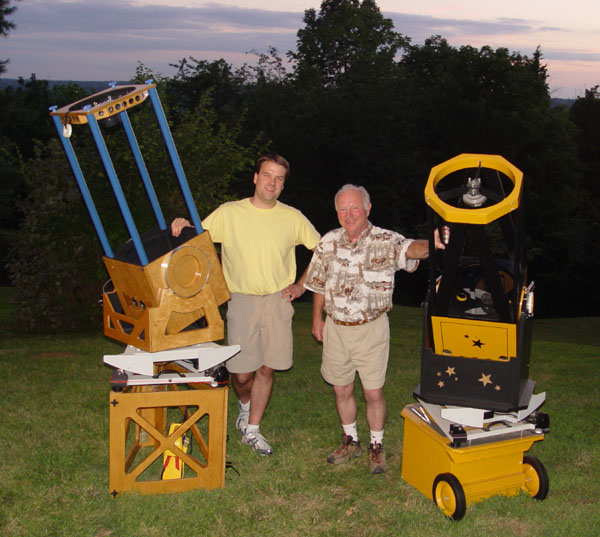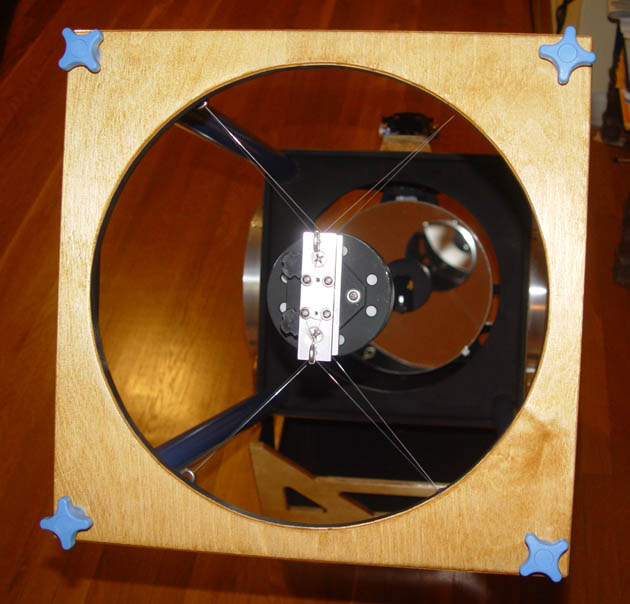12.5" F/12.5 Open-Tube Classical Cassegrain
If you've looked through my web pages describing the CUAS 16.25" F/12.5
Cassegrain work, you have probably seen it mentioned that I was
working on my own 12.5" Cassegrain. I made its secondary in
parallel with the one for the club scope, and I refigured the primary
after it was given to me by Mike Conron.
Click here
to go to the article that I wrote about this telescope for the Cloudy
Nights ATM contest. (I didn't win anything.)
Here are links to pages
with construction photos:
Mirror box and cell construction
photos
Secondary holder and offset wire spider photos
Optical fabrication photos
Other assembly photos
The birth of the idea for this scope came when I saw Dick
Wessling's
13" Cass, mounted like a conventional dobsonian, and sitting on an
equatorial platform. Taking a cue from his scope, I also decided
to divert the cone of light out the top of the mirror box (even though
the mirror was perforated) with an elliptical flat mirror so that it
would be at a more convenient viewing position. The cored mirror
allowed the diagonal (tertiary) to be supported by an assembly that
protruded through the hole - no spider required. Here's a photo
of me (left) and Dick Wessling with our classical Cassegrain telescopes.

This is where our designs diverged. I decided to use four 1.5"
aluminum poles as a tube, and add diagonal bracing only if significant
flexure was observed. The poles have threaded inserts in each end
and screw onto bolts that are mounted in the mirror box. The
secondary cage attaches with knobs which screw into the inserts.
The secondary cage is extremely light weight and features an offset
wire spider
to support the 4" secondary. The wire is stainless steel, 0.015"
thick. To string the spider, the secondary holder was temporarily
attached to a piece of wood that was attached to the wooden cage,
holding the secondary holder in the proper position. Then the
wire was strung and cut, and the wood was removed. The spider is
extremely strong, and does not move laterally at all. Once
properly tentioned, it can be made to move toward or away from the
primary mirror (along
the optic axis), but only with significant pressure.
 Here are few
photos of the telescope. Construction is mainly from
1/2" Baltic Birch plywood (half a sheet). The mirror box and
rocker
box are joined with biscuits and glue, and no fasteners. The
primary
mirror cell frame is made from 3/4" baltic birch, glued and screwed
together. It is a 4-point flotation cell. The primary is 2"
thick, and the secondary is 1" thick. No ventilation fans are
installed yet, but they will be in the future. More will be added
later.
Here are few
photos of the telescope. Construction is mainly from
1/2" Baltic Birch plywood (half a sheet). The mirror box and
rocker
box are joined with biscuits and glue, and no fasteners. The
primary
mirror cell frame is made from 3/4" baltic birch, glued and screwed
together. It is a 4-point flotation cell. The primary is 2"
thick, and the secondary is 1" thick. No ventilation fans are
installed yet, but they will be in the future. More will be added
later.
The first picture shows a side view of the scope. The poles are
painted Rust-Oleum "Royal Blue". I have not found reflections
from the poles to be a problem yet. The tertiary mirror acts as
quite a good baffle, since it is not oversized.
Note the minimal rocker box, and the holes drilled out of the secondary
cage to reduce weight. This results in a very low center of
gravity. The focuser is a Moonlite single-speed crayford,
anodized blue.
The side bearings are 1" thick, and are wrapped in 1/8" thick by 1"
wide aluminum. The focuser sits on a wooden pedestal that raises
it up from the mirror box.
When disassembled, the secondary cage sits safely on top of the mirror
box.
The last two photos here show another view of the scope from the top,
and also looking "down the barrel", showing the offset wire spider and
secondary holder.


So far, the scope has performed well. Planets show good detail,
as do deep sky objects. There were six stars in the Trapezium the
first time I looked through it. Scattered light due to spider
diffraction is present, but in small amounts - less than with a
conventional spider.
I'm still in the tweaking process, and I'll be working on a folding
platform on which the equatorial platform will sit. (I guess
that's a plaform platform.) This will raise the scope up to a
convenient height for viewing while seated. I'll add a page on
the platform platform when it's done.
Update: The "platform platform" is done. It folds up for
storage. Here are a couple of pictures of the scope, set up at
sunset on April 9th, 2004. The clouds dissolved and we enjoyed
good seeing in twilight. The planets looked excellent at 400x and
up.



 Here are few
photos of the telescope. Construction is mainly from
1/2" Baltic Birch plywood (half a sheet). The mirror box and
rocker
box are joined with biscuits and glue, and no fasteners. The
primary
mirror cell frame is made from 3/4" baltic birch, glued and screwed
together. It is a 4-point flotation cell. The primary is 2"
thick, and the secondary is 1" thick. No ventilation fans are
installed yet, but they will be in the future. More will be added
later.
Here are few
photos of the telescope. Construction is mainly from
1/2" Baltic Birch plywood (half a sheet). The mirror box and
rocker
box are joined with biscuits and glue, and no fasteners. The
primary
mirror cell frame is made from 3/4" baltic birch, glued and screwed
together. It is a 4-point flotation cell. The primary is 2"
thick, and the secondary is 1" thick. No ventilation fans are
installed yet, but they will be in the future. More will be added
later.


